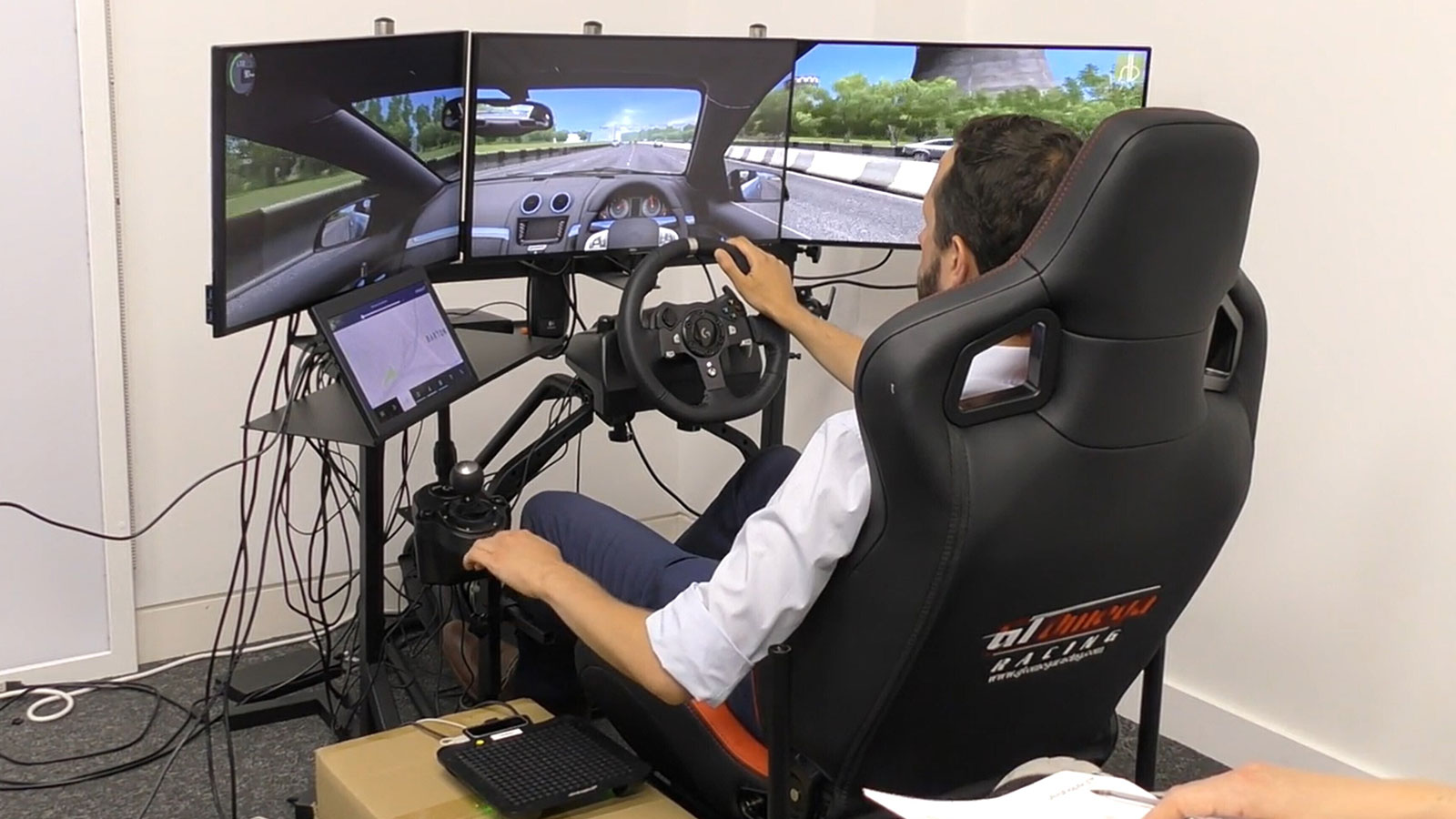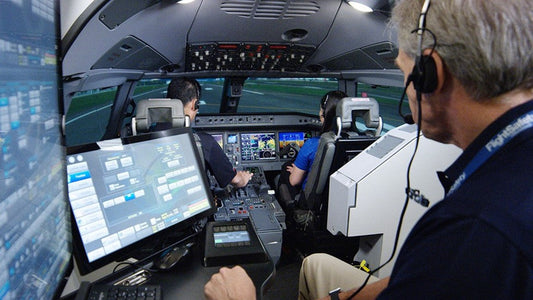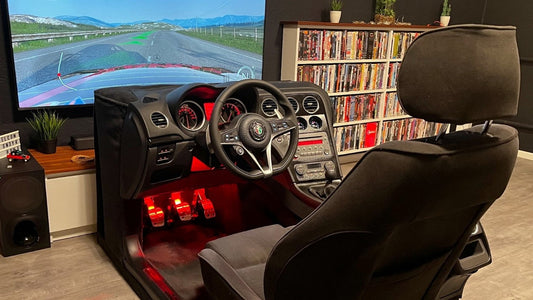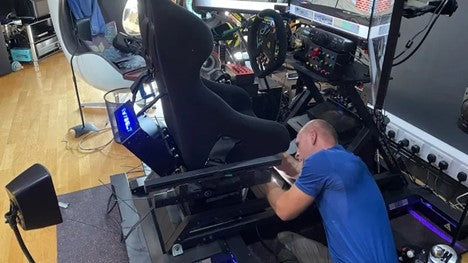How to Improve Your Lap Times in a Racing Simulator

Figure 1: A Person Racing on a Simulator
Spending countless hours practicing only to struggle with poor performance can be frustrating and discouraging. Such setbacks can shake your confidence, blur your focus, and even make progress in sim racing feel out of reach.
But don't let me bring you down! The truth is, you CAN and DO win and become champion! It just takes a different perspective and approach to your current strategy. Sometimes, small but smart adjustments can make all the difference in improving lap times in a racing simulator.
In this article, we’ve compiled all the tips to help you unlock your true potential and get faster at sim racing. Let’s dive in!
Get Your Fundamentals Right
Car Control

Figure 2: AC Competizione Gameplay Footage
The most important aspect of sim racing is car control, which lays the foundation for everything else you want to accomplish while racing on your simulator. We suggest starting with mastering the art of gradual steering.
The more you master gradual steering, the more you're going to have gradual throttle and brake pressure, remaining on track even during painstakingly slow hairpin turns.
Racing Line
Once you've mastered gradual steering, the next thing is knowing the racing line. The racing line is how you're supposed to turn, cutting distance and building speed on entering/exiting corners. Essentially, you have to figure out how to cut the apex of a turn, the point at which your car gets closest to the turn. Turning at the apex of a turn means you can go in and out in a straight line to maintain speed or accelerate even more.Moreover, since you're going to want to have track awareness all the time, we highly recommend you study maps, observe skilled drivers, or use in-game tools in your free time to familiarize yourself with each course. Trust me, when done right, this tremendously improves lap times in a racing simulator.
Brake Point Precision

Figure 3: AC Competizione Gameplay Footage
The other thing to keep in mind is brake point accuracy. The moment you determine how early or late you need to brake going into each corner is seconds added to or subtracted from your lap time.
Smooth Inputs and Weight Transfer
Finally, smooth inputs and weight transfer also play a huge role in maintaining control and speed. If you jerk the wheel or stab the throttle, you'll throw off the car's balance and your tempo which makes you slower.Therefore, be gentle. Apply gas or brake as gently as you would turn the wheel so that everything is more appropriately aligned to turn better and exit quicker. This is similar to maintaining cornering momentum, which is immediately impactful as opposed to lap time. Master these fundamentals and you'll not only discover the ability to drive faster during laps but also consistently lap after lap
Analyze and Compare Telemetry Data
Study Telemetry Data

Figure 4: Sim Racing Telemetry Data
Telemetry data is indeed one of your most valuable resources. It tracks everything you do behind the wheel in a quantifiable manner such as by indicating where you enter a turn and how you exit. It also shows how much throttle or braking you apply in a specific sector. So from that data, you can understand how the car reacts based on your actions.
For instance, if you notice you're losing speed because of heavy braking, you can work on braking more smoothly.
Record and Analyze Lap Data
One of the best ways to get better at sim racing is to monitor and review your lapping data afterward. Use all telemetry options available to monitor not only your lap times but also your turns, unofficial apexes, and segment times. More sophisticated programs like MoTeC and VRS facilitate telemetry comparisons, side-by-side views, and recaps of laps and races. These software tracks lap times, sector splits, throttle percentages, and braking strengths to give you a full analysis of your performance.By comparing data from different sessions, you can spot patterns and find areas where you can improve. Maybe you're braking too early, or perhaps you're not carrying enough speed through certain corners. Identifying these details is a key step to getting faster at sim racing.
Join Communities and Compare Stats with Faster Drivers

Figure 5: Formula 1 Race Cars
Another great way to improve is by comparing yourself with faster drivers. If possible, get a lapping session with someone you know who averages lap times faster than you. If not, perhaps scour the internet for pros with lap telemetries or well-rated drivers who will help.
Moreover, there are countless forums online where you can even post your times and get feedback. Sure, a slew of amateurs will respond and tell you how to gain a couple of seconds on your lap time for a racing simulation.
Look Up the Game Menu and Optimize Your Car Setup

Figure 6: AC Competizione Game Menu Settings
Many racers dive straight into the setup menus of their racing game, hoping to find quick improvements. While optimizing your car setup can indeed lead to faster lap times, making you get better at sim racing, it’s important to approach this step carefully and patiently.
This way, you'll understand exactly what worked, what didn't, what helped, and what hurt. Yes, it's a long and boring process, but in the end, you'll know your car better than its paint job and upholstery and understand what minor adjustments can get it to perform at its best.
Test Different Racing Strategies

Figure 7: A Sim Racer Testing a New Race Strategy
Sticking to a single driving style might feel comfortable, but it can also limit your potential. We get it. You enjoy what you enjoy because you want to feel comfortable behind the wheel and you've probably established something that works for you.
If you’re hesitant, then practice with AI opponents or in private sessions. Use this time to experiment with different race starts, alternative cornering lines, or driving with a full fuel load. Try extending your stints or switching tire compounds to understand wear rates and efficiency. And just like that, test different styles and make note of changes that make you improve lap times in a racing simulator.
Regular Mental and Physical Exercise

Figure 8: A Person Running Up a Hill
Sim racing is as much a mental challenge as it is a physical one, especially during intense events or long races. This is where mental exercises like visualization and concentration techniques come in handy to improve focus and performance.
Physical fitness also plays a key role in sim racing. For instance, core workouts like planks or leg raises will tighten your core which contributes to stability and reduces fatigue over long races. Reaction time is equally important; quick reflexes can help you avoid collisions or adapt to sudden changes on the track. Simple activities like reaction-based games with a reaction ball can sharpen your split-second decision-making.
So, what do you think of all the tips provided to improve lap times in a racing simulator? Did they prove helpful to you? Share your thoughts with us and let us know in the comments down below!





